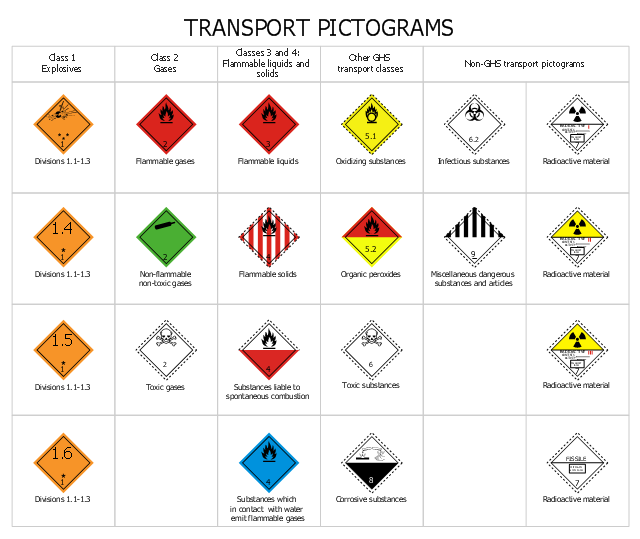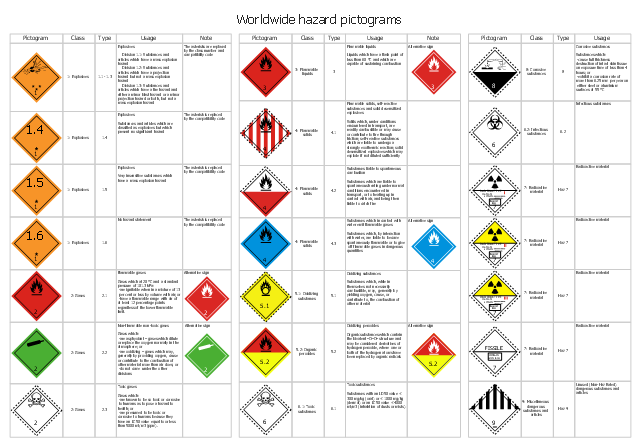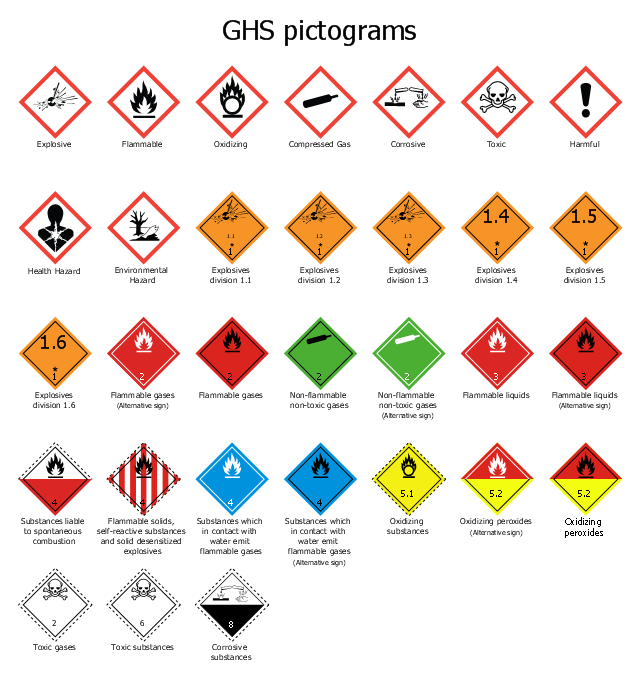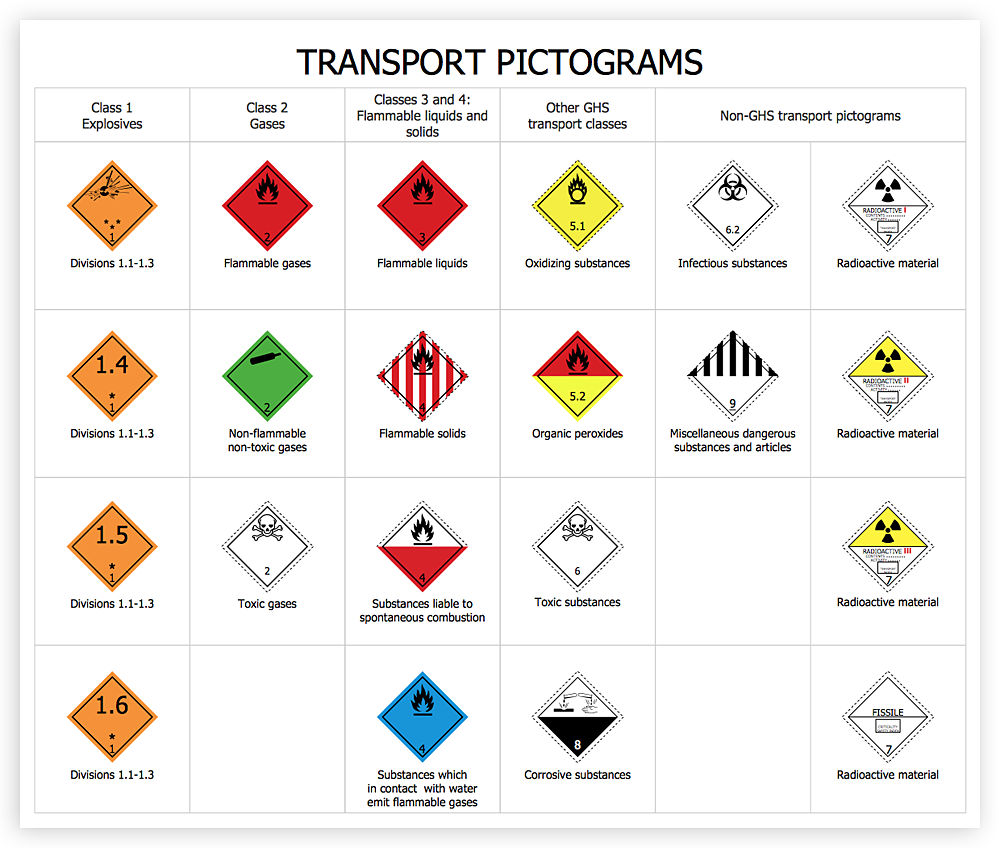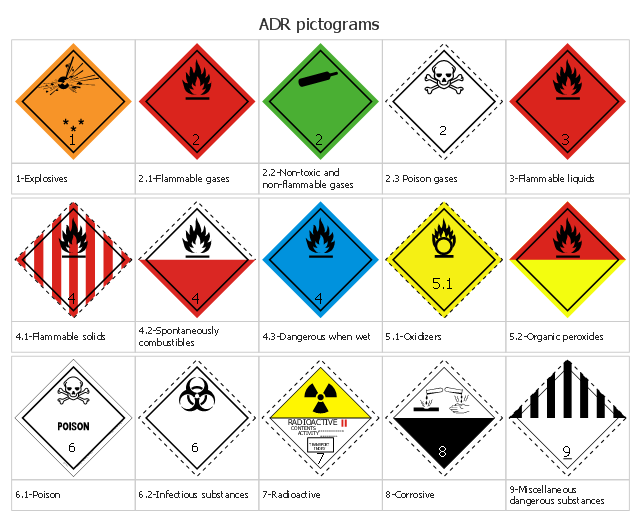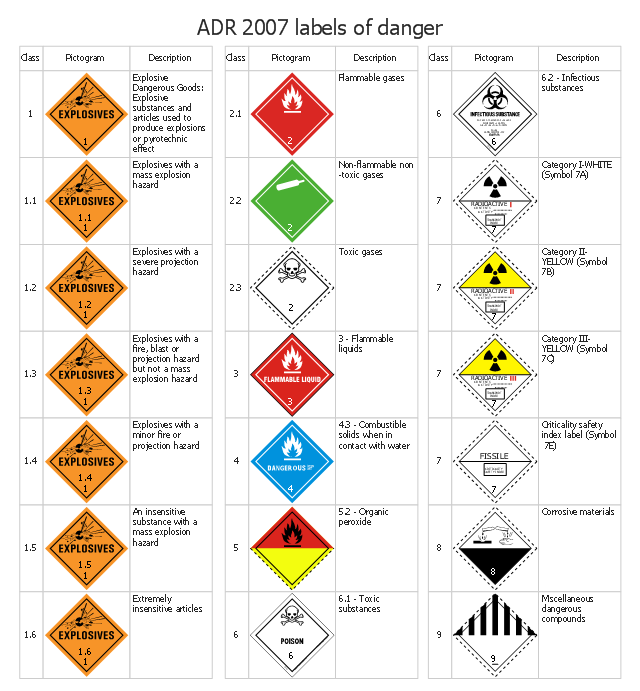 Transport Hazard Pictograms
Transport Hazard Pictograms
Transport Hazard Pictograms solution includes large variety of specially developed samples with transport hazard symbols and pictograms, and the whole set of predesigned vector transport GHS pictograms download and used with ease from the Transport Hazard Pictograms library. Apply them for quick designing professional-looking infographics and diagrams, use them to create warning signboards and announcements on all stages of the transportation process, to place them on the transport vehicles and warehouses of transportation companies, at the transport documentation and on the websites of transport and logistics companies.
This transportation safety infographic shows the hazard pictograms for Class 1 Explosives, Class 2 Gases, Class 3 Flammable liquids, Class 4 Flammable solids, Class 5 Oxidizers, Class 6 Toxic substances, Class 7 Radioactive materials, Class 8 Corrosive substances, Class 9 Miscellaneous dangerous substances.
The GHS hazard symbols infographic example "Transport pictograms" was designed using ConceptDraw PRO software extended with the Transport Hazard Pictograms solution from the Engineering area of ConceptDraw Solution Park.
The GHS hazard symbols infographic example "Transport pictograms" was designed using ConceptDraw PRO software extended with the Transport Hazard Pictograms solution from the Engineering area of ConceptDraw Solution Park.
This transportation safety infographic shows the Worldwide hazard pictograms.
"Dangerous goods or hazardous goods are solids, liquids, or gases that can harm people, other living organisms, property, or the environment. They are often subject to chemical regulations. In the United States, United Kingdom and sometimes in Canada, dangerous goods are more commonly known as hazardous materials (abbreviated as HAZMAT or hazmat). Hazmat teams are personnel specially trained to handle dangerous goods, which include materials that are radioactive, flammable, explosive, corrosive, oxidizing, asphyxiating, biohazardous, toxic, pathogenic, or allergenic. Also included are physical conditions such as compressed gases and liquids or hot materials, including all goods containing such materials or chemicals, or may have other characteristics that render them hazardous in specific circumstances." [Dangerous goods. Wikipedia]
The GHS transport symbols infographic example "Worldwide hazard pictograms" was designed using ConceptDraw PRO software extended with the Transport Hazard Pictograms solution from the Engineering area of ConceptDraw Solution Park.
"Dangerous goods or hazardous goods are solids, liquids, or gases that can harm people, other living organisms, property, or the environment. They are often subject to chemical regulations. In the United States, United Kingdom and sometimes in Canada, dangerous goods are more commonly known as hazardous materials (abbreviated as HAZMAT or hazmat). Hazmat teams are personnel specially trained to handle dangerous goods, which include materials that are radioactive, flammable, explosive, corrosive, oxidizing, asphyxiating, biohazardous, toxic, pathogenic, or allergenic. Also included are physical conditions such as compressed gases and liquids or hot materials, including all goods containing such materials or chemicals, or may have other characteristics that render them hazardous in specific circumstances." [Dangerous goods. Wikipedia]
The GHS transport symbols infographic example "Worldwide hazard pictograms" was designed using ConceptDraw PRO software extended with the Transport Hazard Pictograms solution from the Engineering area of ConceptDraw Solution Park.
This chemical safety infographic shows the GHS hazard pictograms.
"Hazard pictograms are one of the key elements for the labelling of containers under the GHS, along with:
* an identification of the product;
* a signal word – either Danger or Warning – where necessary
* hazard statements, indicating the nature and degree of the risks posed by the product
* precautionary statements, indicating how the product should be handled to minimize risks to the user (as well as to other people and the general environment)
* the identity of the supplier (who might be a manufacturer or importer)" [GHS hazard pictograms. Wikipedia]
The transport hazard symbols infographic example "GHS pictograms" was designed using ConceptDraw PRO software extended with the Transport Hazard Pictograms solution from the Engineering area of ConceptDraw Solution Park.
"Hazard pictograms are one of the key elements for the labelling of containers under the GHS, along with:
* an identification of the product;
* a signal word – either Danger or Warning – where necessary
* hazard statements, indicating the nature and degree of the risks posed by the product
* precautionary statements, indicating how the product should be handled to minimize risks to the user (as well as to other people and the general environment)
* the identity of the supplier (who might be a manufacturer or importer)" [GHS hazard pictograms. Wikipedia]
The transport hazard symbols infographic example "GHS pictograms" was designed using ConceptDraw PRO software extended with the Transport Hazard Pictograms solution from the Engineering area of ConceptDraw Solution Park.
HelpDesk
How To Design Warning Infographics Using Transport Hazard Pictograms
A hazard pictogram is intended to provide information about the hazard that can cause a damage of a human health or the environment. GHS Hazard pictogram consists from a standard hazard symbol placed to the shape of a red diamond with a white background. GHS Hazard Pictograms solution from the ConceptDraw Solution Park includes the set of standardized GHS hazard pictograms. It can be used for creating safety infographics, warning announcements, labels and regulatory documentation containing the elements of OSHA HAZCOM Standard.This transportation safety infographic shows the ADR pictograms.
"ADR (formally, the European Agreement concerning the International Carriage of Dangerous Goods by Road (ADR)) is a 1957 United Nations treaty that governs transnational transport of hazardous materials. "ADR" is derived from the French name for the treaty: Accord européen relatif au transport international des marchandises Dangereuses par Route). ... The agreement itself is brief and simple, and its most important article is article 2. This article states that with the exception of certain exceptionally dangerous materials, hazardous materials may in general be transported internationally in wheeled vehicles, provided that two sets of conditions be met:
1. Annex A regulates the merchandise involved, notably their packaging and labels.
2. Annex B regulates the construction, equipment, and use of vehicles for the transport of hazardous materials." [ADR (treaty). Wikipedia]
The GHS transport hazard symbols infographic example "ADR pictograms" was designed using ConceptDraw PRO software extended with the Transport Hazard Pictograms solution from the Engineering area of ConceptDraw Solution Park.
"ADR (formally, the European Agreement concerning the International Carriage of Dangerous Goods by Road (ADR)) is a 1957 United Nations treaty that governs transnational transport of hazardous materials. "ADR" is derived from the French name for the treaty: Accord européen relatif au transport international des marchandises Dangereuses par Route). ... The agreement itself is brief and simple, and its most important article is article 2. This article states that with the exception of certain exceptionally dangerous materials, hazardous materials may in general be transported internationally in wheeled vehicles, provided that two sets of conditions be met:
1. Annex A regulates the merchandise involved, notably their packaging and labels.
2. Annex B regulates the construction, equipment, and use of vehicles for the transport of hazardous materials." [ADR (treaty). Wikipedia]
The GHS transport hazard symbols infographic example "ADR pictograms" was designed using ConceptDraw PRO software extended with the Transport Hazard Pictograms solution from the Engineering area of ConceptDraw Solution Park.
This transportation safety infographic shows the ADR 2007 labels of danger.
"Hazard symbols according to the Accord européen relatif au transport international des marchandises Dangereuses par Route (ADR) (European agreement about international transport of hazardous goods by road) and Reglement concernant le transport international ferroviaire de marchandises Dangereuses (RID) (Rules about international railway transport of hazardous goods), promoted by UNECE ECOSOC (Dangerous Goods, unece.org).
Also used by International Maritime Code for Dangerous Goods (IMDG) for overseas shipping by UN-IMO, International Maritime Organization (IMDG-Code, imo.org)." [ADR labels of danger. Wikimedia Commons]
The GHS transport hazard symbols infographic example "ADR 2007 labels of danger" was designed using ConceptDraw PRO software extended with the Transport Hazard Pictograms solution from the Engineering area of ConceptDraw Solution Park.
"Hazard symbols according to the Accord européen relatif au transport international des marchandises Dangereuses par Route (ADR) (European agreement about international transport of hazardous goods by road) and Reglement concernant le transport international ferroviaire de marchandises Dangereuses (RID) (Rules about international railway transport of hazardous goods), promoted by UNECE ECOSOC (Dangerous Goods, unece.org).
Also used by International Maritime Code for Dangerous Goods (IMDG) for overseas shipping by UN-IMO, International Maritime Organization (IMDG-Code, imo.org)." [ADR labels of danger. Wikimedia Commons]
The GHS transport hazard symbols infographic example "ADR 2007 labels of danger" was designed using ConceptDraw PRO software extended with the Transport Hazard Pictograms solution from the Engineering area of ConceptDraw Solution Park.
 Rapid UML
Rapid UML
Rapid UML solution extends ConceptDraw PRO software with templates, samples and libraries of vector stencils for quick drawing the UML diagrams using Rapid Draw technology.
- Transport Hazard Pictograms | How To Design Warning Infographics ...
- GHS hazard symbols | Design elements - GHS hazard pictograms ...
- Data structure diagram with ConceptDraw PRO | Transport Hazard ...
- New Transport Hazard Pictograms Solution for ConceptDraw PRO v11
- Marketing - Design Elements | UML Class Diagram Example for ...
- ADR pictograms | ADR 2007 labels of danger | Worldwide hazard ...
- Transport Hazard Pictograms | Make A Chart On Computer Of Class9
- ADR pictograms
- Transport Hazard Pictograms | Design elements - GHS hazard ...
- Road Transport - Design Elements | Industrial transport - Design ...
